The Federation Bathroom
[Previous post: Abbotsford Grandeur Next post: Historic Kirribilli ]Table of Contents
1. Edwardian bathrooms

Generally speaking, the “Edwardian Period” is considered to be the period from 1901 to about 1920, which comprises the rule of King Edward VII and about a decade after his death. This is the period immediately following the death of Queen Victoria (and the end of the Victorian Era), and is stylistically different in a few ways for some major cultural reasons.
- First and foremost, by 1901 the middle class had begun to rise up suburbs, meaning lots of new construction and plenty of room for a new architectural style.
- This was also the time that both electricity and indoor plumbing began to become widespread, and the presence of servants in the home began to recede.
- Together, that made for wide, open rooms in lighter (non-soot-hiding) colors in simple, easy-to-clean designs.
2. Edwardian Toilets

When indoor plumbing had only just begun to become common during the Edwardian period, it’s important to remember that that means the first flushable toilets.
- Before this time, the facilities were limited to chamber pots and outhouses, and during the Edwardian period toilet designs weren’t what they are today.
- For the most historically accurate Edwardian bathroom, a cistern style toilet is recommended, where the tank is elevated high above the bowl and connected by a thin metal pipe, but many of the other designs of the time are neither in production nor particularly practical.
- Because of the latter, if going to break from historical accuracy, this is probably the one place to get away with it. Most people don’t realize that the use of flush toilets is hardly 100 years old, so even just a decorative wooden toilet seat can probably get one by just fine.
3. Indoor Plumbing, Indoor Bathing

Before the Edwardian period, bathrooms and regular bathing were considered to be unnecessary, even decadent. But with the advent of widespread indoor plumbing, the notion of a permanent space reserved for toiletries was integrated into home architecture for the first time.
- Previously, both tubs and toilets were portable and not necessarily private (in fact, bathing was often a once-weekly family affair), but the invention of the enameledclawfoot tub by Kohler Co in 1883 replaced temporary tin tubs with permanent fixtures. Edwardian bathrooms featured oval-shaped clawfoot tubs with an even rolled trim all the way around, like the Roll Top Cast Iron Clawfoot from Elizabethan Classics for example.
- Bathrooms were still large and made for family use during this period, but were very much in line with the overall aesthetic of cleanliness.
- In an Edwardian bathroom, there’s tile across the whole floor and tile or wainscotting half or a third of the way up the wall to make the surfaces easy to clean, and the walls above topped with light pastel colors or floral patterns.
- Empty corners and open spaces were the rule, with only as much exposed plumbing as was expressly needed to fill a Clawfoot Tub and feed the Console Sink and toilet.
- Edwardian bathrooms, as with the rest of Edwardian architecture, utilized lots of natural light, so there’re lots of large windows, light pastel color schemes, and often bouquets of fresh flowers to emphasize the bright, natural aspect of the bathroom.
4. Bright, Open Bathrooms; Bright Open Fixtures

The form of Edwardian bathroom fixtures followed the architecture and overall design of the time, emphasizing light colors and open spaces.
- Revolutions in toilet technology meant that ceramic porcelain was becoming widely used, and the material was repeated in clawfoot tubs and simple, open console sinks. Mirrors and artwork were simple, with simple Mirror Frames.
- Ceilings were sometimes decorative, with molding or murals, but not nearly to the extent found in Victorian bathrooms. The ceiling decorations were simpler, easier to clean, and done in lighter colors because they didn’t have to hide soot or smudges from gas lanterns.
- Unlike Victorian design, Edwardian bathrooms tended to have relatively very little ornamentation. While Victorian design favored lots of small knick-knacks and decorations, Edwardians preferred an uncluttered aesthetic, again relying primarily on floral ornamentation with some smaller clusters of decorations.
- Edwardian bathrooms were often decorated with beautiful leaded glass windows and large, ornamental or oriental rugs.
- Simple porcelain fixtures all offer a simple elegance, accessorized by decorative wall tile, the rug and window panes, and even the cloth of the curtain or paint or floral wallpaper on the walls.[1]
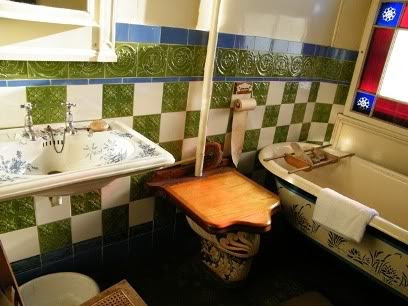 |
| Victorian bathroom with luxurious decorated porcelain |
|
|
|
| Picture Gallery |
"A typical Federation bathroom had a tiled floor and tiled walls, with a free-standing cast-iron bath, sitting on four clawfeet.
- Pipes were usually nickel-plated and exposed to view.
- A large, perforated shower-head stood ready to deluge anyone rash enough to turn the tap.
- Sturdy nickel-plated taps were fitted to both the bath and the nearby wash-basin or 'lavatory' as it was then known.
- Hot water came from a reservoir in the kitchen range, or ...from a chip heater".[2]
- And the loo had its own room at the back of the house, or even at the back of the garden.
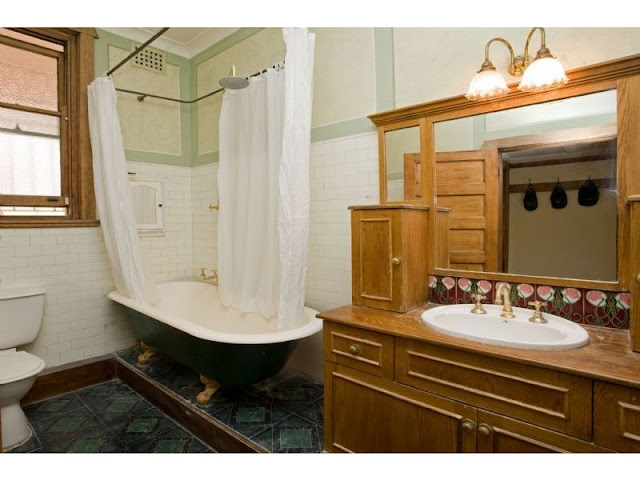
Original bathroom at 17 Holbrook Avenue, Kirribilli
 |
| Original Federation bathroom with beautiful tapware of the period |
"In the short half-century between 1875 and 1925 – the period of time between when indoor plumbing began to be
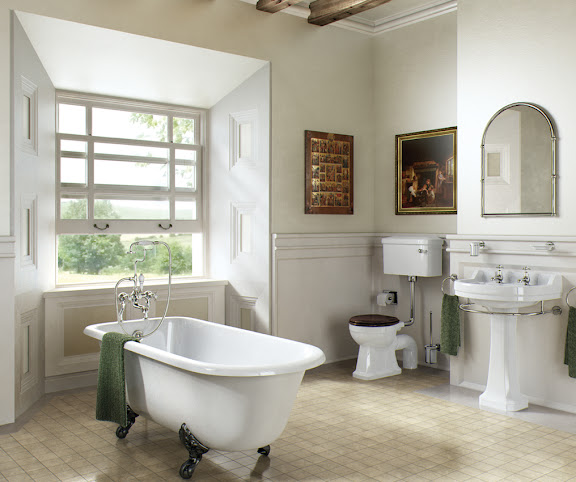 |
| Modern Edwardian style bathroom fixtures |
widely available and when it became almost universal – our attitudes toward privacy and modesty changed significantly.
What were once communal and family activities have become very personal and private activities."[3]
"Before running water, washing up, bathing, and (using the loo) happened in different places.
- Washing took place at a washstand in the bedroom, with a pitcher and a bowl;
- (the loo was) in the outhouse or the chamber pot;
- bathing, when it occasionally happened, was often in a tub by the stove in the kitchen, where the hot water was."[4]
Edwardian Tiling
Gallery: click on thumbnail for larger view |  |  |
|---|
| A reconstructed Victorian style bathroom with wooden floor and furniture, showing pitcher and bowl, 'modern' decorated handbasin (lavatory). Thomas Crapper equipped decorated toilet installed! |
Revolutionary indoor plumbing:
"Thanks to the Industrial Revolution, steps were taken to mechanise the bathroom. Hot water could be produced for use in the home, and so personal bathing became much more common.| Original Federation style bathroom with modern shower and tap ware and no loo yet. |
 |
| Almost original inter-war style bathroom with classic hand basin and pine dresser. |
Fall of the pedestal hand basin:
Note how the Victorian pedestal hand basin has given way to the modern combination vanity unit, with the wash basin again part of a more utilitarian bathroom design.- Most Federation vanity units are made of wood, such as cedar, mahogany, or oak.
- A pedestal hand basin atop a tall, slender base is often considered a vintage look.
- marble top dressers with pitcher and ewer are early Victorian style, supplanted by the pedestal basin.
- Here are examples of a Federation vanity basin set installed in wooden furniture:
 |
| Federation style powder room |
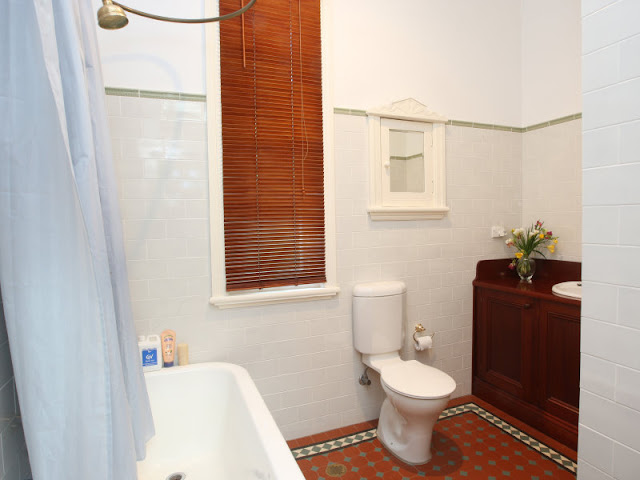 |
| Original federation tiled bathroom floor and handbasin cabinet and the loo finally gets installed in the bathroom. |
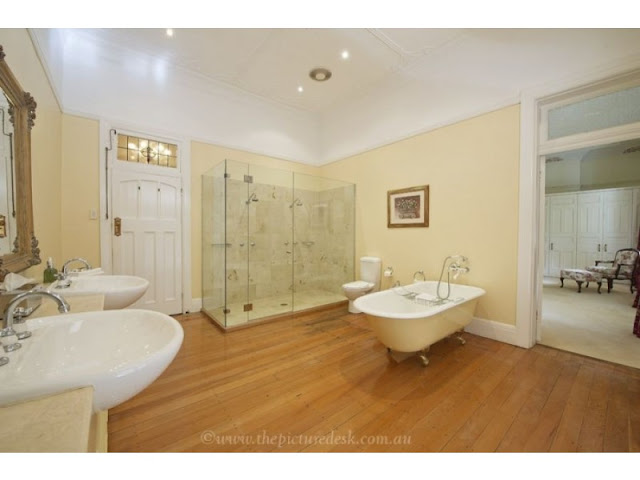 |
| Original period bathroom with updated twin shower stall and twin handbasins and the loo has been installed. |
| Period bathroom with plenty of decorative style and a spa bath |
Modernised bathrooms:
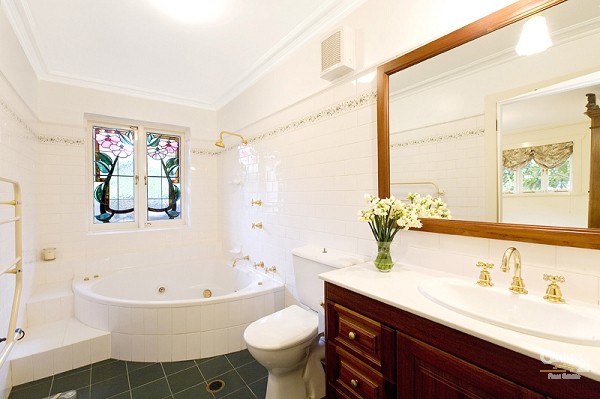
 |
| Largely original floor and wall tiling and marble top handbasin unit |
 |
| Carefully modernised Federation bathroom with original tiling |
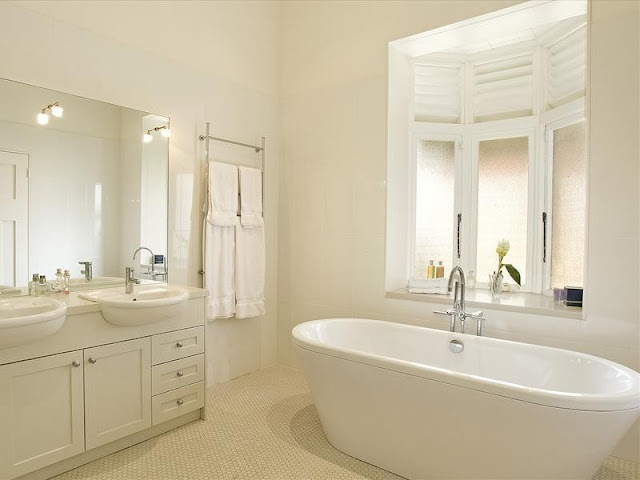 |
| A modern take on an Edwardian bathroom, with bay window casements and built-in vanity unit. The loo is banished to a separate room |
 |
| Modern take on a Federation style |
 |
| Fully updated, but the window still shows the heritage style |
More bathroom inspirations:I like this site: http://freshome.com/2010/06/01/30-beautiful-and-relaxing-bathroom-design-ideas/
- ^ http://www.prweb.com/releases/Edwardian-bathroom-design/period-style-bathroom/prweb9887137.htm
- ^ From "The Federation House - A Restoration Guide" by Ian Evans, page 23
- ^
http://www.victoriaplumb.com/bathroom_DIY/history_of_toilets.html
- accessed 4/11/2012 - ^ http://www.treehugger.com/bathroom-design/the-history-of-the-bathroom-part-3-putting-plumbing-before-people.html
- ^
http://www.victoriaplumb.com/bathroom_DIY/history_of_toilets.html






No comments:
Post a Comment